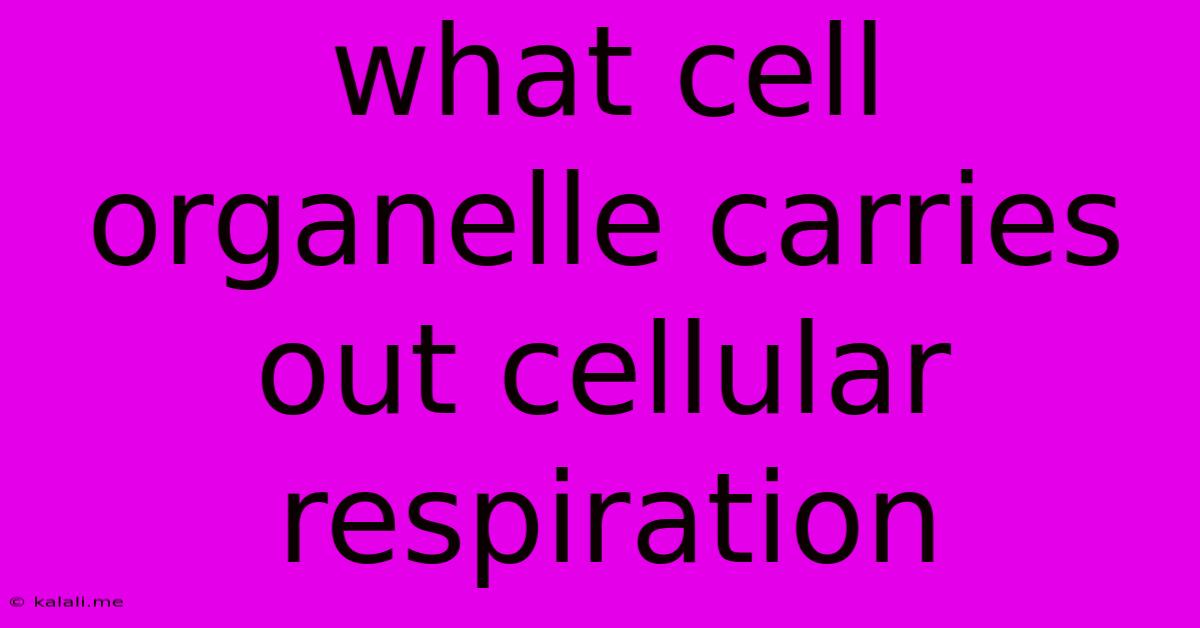What Cell Organelle Carries Out Cellular Respiration
Kalali
Jun 15, 2025 · 3 min read

Table of Contents
The Powerhouse of the Cell: Understanding Cellular Respiration and the Mitochondria
Cellular respiration is the process that provides energy for almost all living things. This vital process converts the chemical energy stored in food molecules, primarily glucose, into a readily usable form of energy called ATP (adenosine triphosphate). But which cell organelle is responsible for this crucial task? The answer is the mitochondria. This article will delve into the role of mitochondria in cellular respiration, exploring its structure and the stages involved in this complex process.
The Mitochondria: Structure and Function
The mitochondria are often referred to as the "powerhouses" of the cell due to their critical role in energy production. These double-membrane-bound organelles have a unique structure that facilitates their function. The outer membrane is smooth, while the inner membrane is extensively folded into cristae. These cristae significantly increase the surface area available for the electron transport chain, a crucial step in cellular respiration. The space between the two membranes is called the intermembrane space, while the space enclosed by the inner membrane is called the matrix. The matrix contains enzymes necessary for various stages of cellular respiration, including the Krebs cycle.
Stages of Cellular Respiration: A Mitochondrial Symphony
Cellular respiration is a multi-step process broadly categorized into four main stages:
-
Glycolysis: This initial step occurs in the cytoplasm, outside the mitochondria. Glucose is broken down into pyruvate, producing a small amount of ATP and NADH (a high-energy electron carrier).
-
Pyruvate Oxidation: Pyruvate, the product of glycolysis, enters the mitochondrial matrix. Here, it's converted into acetyl-CoA, releasing carbon dioxide and producing more NADH.
-
Krebs Cycle (Citric Acid Cycle): This cycle takes place within the mitochondrial matrix. Acetyl-CoA enters a series of reactions, generating ATP, NADH, FADH2 (another electron carrier), and releasing carbon dioxide.
-
Electron Transport Chain (ETC) and Oxidative Phosphorylation: This is the final and most significant stage, occurring across the inner mitochondrial membrane. Electrons from NADH and FADH2 are passed along a chain of protein complexes, releasing energy. This energy is used to pump protons (H+) into the intermembrane space, creating a proton gradient. These protons then flow back into the matrix through ATP synthase, an enzyme that uses this energy to produce a large amount of ATP. Oxygen acts as the final electron acceptor in this chain, forming water.
The Importance of Mitochondria in Cellular Health
The proper functioning of mitochondria is essential for overall cellular health. Mitochondrial dysfunction has been implicated in a wide range of diseases, including neurodegenerative disorders, metabolic diseases, and cancer. Understanding the intricate processes within these organelles is crucial for developing effective treatments and therapies for these conditions. Research continues to uncover the complex roles of mitochondria and their impact on human health.
Conclusion: The Essential Role of Mitochondria
In conclusion, the mitochondria are the key players in cellular respiration, the process that provides the energy necessary for life. Their unique structure, with its folded inner membrane and specialized compartments, facilitates the efficient conversion of glucose into ATP. The four stages of cellular respiration – glycolysis, pyruvate oxidation, the Krebs cycle, and the electron transport chain – work in concert within and around the mitochondria to generate the energy that powers our cells. Further research continues to illuminate the importance of mitochondrial health in maintaining overall well-being.
Latest Posts
Latest Posts
-
Sum Of Odd Numbers 1 To 100
Jun 16, 2025
-
The Asthenosphere Is Part Of The
Jun 16, 2025
-
How Many Meters In A Square Mile
Jun 16, 2025
-
Organelles Which Contain Dna Include The
Jun 16, 2025
-
How Many Chambers Are Found In A Mammalian Heart
Jun 16, 2025
Related Post
Thank you for visiting our website which covers about What Cell Organelle Carries Out Cellular Respiration . We hope the information provided has been useful to you. Feel free to contact us if you have any questions or need further assistance. See you next time and don't miss to bookmark.